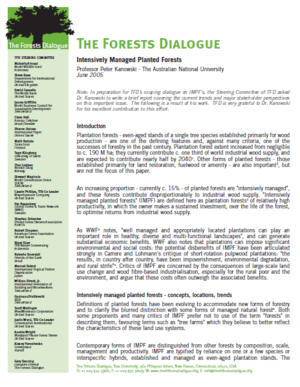Intensively Managed Planted Forests
Plantation forests - even-aged stands of a single tree species established primarily for wood production - are one of the defining features and, against many criteria, one of the successes of forestry in the past century. Plantation forest extent increased from negligible to c. 190 M ha; they currently contribute c. one third of world industrial wood supply, and are expected to contribute nearly half by 20401. Other forms of planted forests - those established primarily for land restoration, fuelwood or amenity - are also important, but are not the focus of this paper.
An increasing proportion - currently c. 15% - of planted forests are “intensively managed”, and these forests contribute disproportionately to industrial wood supply. “Intensively managed planted forests” (IMPF) are defined here as plantation forests of relatively high productivity, in which the owner makes a sustained investment, over the life of the forest,
to optimise returns from industrial wood supply. As WWF notes, “well managed and appropriately located plantations can play an important role in healthy, diverse and multi-functional landscapes”, and can generate substantial economic benefits. WWF also notes that plantations can impose significant environmental and social costs: the potential disbenefits of IMPF have been articulated strongly in Carrere and Lohmann’s critique of short-rotation pulpwood plantations: “the results, in country after country, have been impoverishment, environmental degradation, and rural strife”. Critics of IMPF are concerned by the consequences of large-scale land use change and wood fibre-based industrialisation, especially for the rural poor and the environment, and argue that these costs often outweigh the associated benefits.

